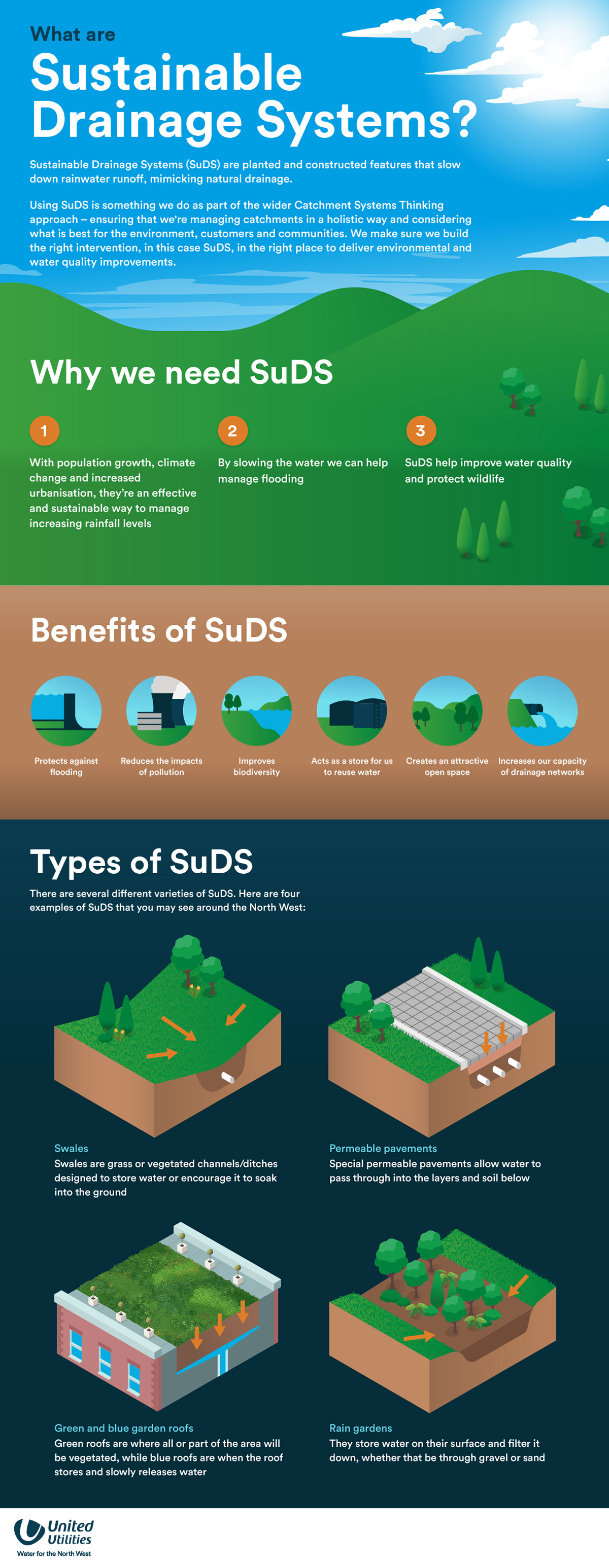A sustainable solution
It might feel like it rains a lot in the North West. And you’d be right, it does. But where does all the rainfall go?
When rain hits the ground, it becomes surface water and it’s our job to take care of the drainage water from buildings.
One way we take care of rainfall is through Sustainable Drainage Systems, otherwise known as SuDS. They are planted and constructed features that slow down rainwater runoff mimicking natural drainage.
By slowing the water, we can help manage flooding, improve water quality, and protect wildlife and plants.
With climate change upon us and water becoming ever more precious, we need to make sure we sustainably look after this vital resource once it falls from the sky!
So, how do SuDS work?
Firstly, let’s take a look at how rainfall is managed in nature. When it rains, the water soaks into the ground, or it moves through the soil as groundwater. Once the ground is wet, the water will run off and be collected by ditches, streams, ponds or rivers. Then, once it stops raining, water evaporates from the soil’s surface.
With that natural process in mind, let’s think of an ever-increasing population and what comes with that; new homes, office blocks and urbanisation. All of this development means less green space and land can struggle to soak up the surface water.
And this is where SuDS come in! We can create these features that are sustainable and great for the environment to help with the drainage. And the great news is that all of the new developments we’re seeing across our towns and cities are able to manage this surface water better than ever before as we implement SuDS. They are flexible and are adaptable to future climate changes. We’re also looking at how we incorporate them into existing developed urban areas too.
Where might I see SuDS?
There are many different types of SuDS and the drainage solution for a particular area will be chosen on a case-by-case basis depending on factors including ground conditions, the local flood risk management already in place, and the local hydrology (the study of water).
Some examples include:
- Green and blue roofs - The roof of a building that can be designed to store water. Green roofs are where all or part of the area will be vegetated, while blue roofs are when the roof stores and slowly releases water.
- Permeable pavements – Unlike traditional paving materials, special permeable pavements allow water to pass through into the layers and soil below.
- Swales - A bit like a shallow ditch, but with a flat bottom, swales are grass or vegetated channels/ditches designed to store water or encourage it to soak into the ground.
- Bio-retention systems – Commonly referred to as rain gardens, these can be designed in lots of different ways. They store water on their surface and filter it down, whether that be through gravel or sand.
- Basins (detention or infiltration) – These are shallow depressions that are usually dry, in that they are without water most of the time. They are designed to handle runoff after increased rainfall, reducing the risk of flooding.
- Wetlands – Wetlands help slow down the flow of water during periods of heavy rainfall (see our wetland infographic to find out more about wetlands).
- Soakaways – These are below ground features that can be filled with aggregate (a sand/gravel material). They are designed to store water and allow it to infiltrate into the ground over a period of time. Unlike alternative SuDS, they are mainly not visible at the surface but could have a gravel layer above.
SuDS and Catchment Systems Thinking
So, there you have it. You’ve discovered more about SuDS, how they work, and why we’re so enthusiastic about implementing them. The next time you’re out and about, why not see if you can spot a SuDS and pinpoint which one you can see? Surface water is a valuable resource, and we believe this should be reflected in the way it is managed.
SuDS is just a small part of the wider Catchment Systems Thinking (CaST) approach – managing catchments in a holistic and integrated manner; looking at the wider environment to consider what is best for the environment, customers, and communities.
We make sure we build the right intervention - in this case SuDS - in the right place to deliver environmental and water quality improvements for many years. We don’t just consider the water quality at the end of the line, we think about everyone, every entity, and every habitat who interact with it!
Catchment Systems Thinking
Watch our video to learn more about Catchment Systems Thinking.
